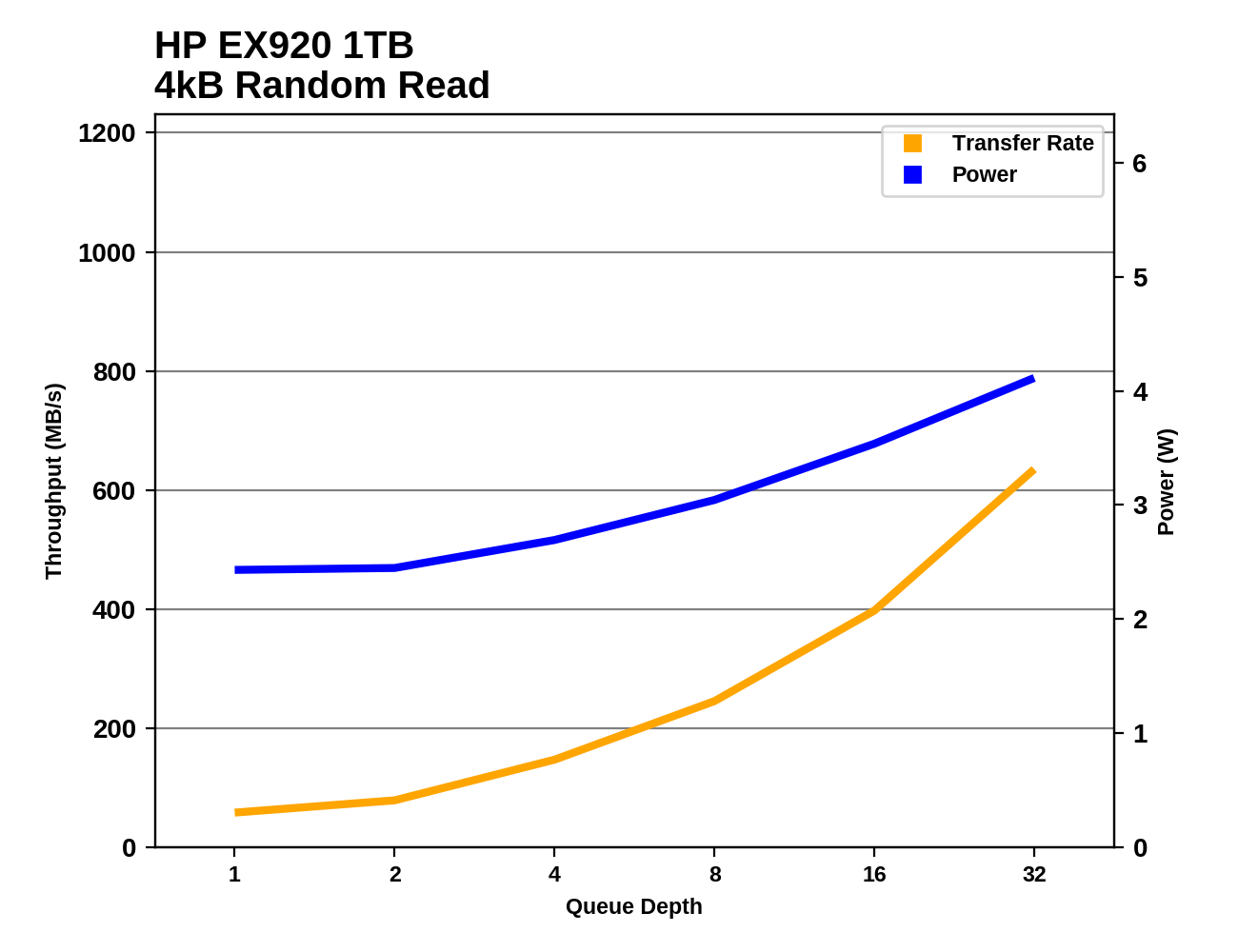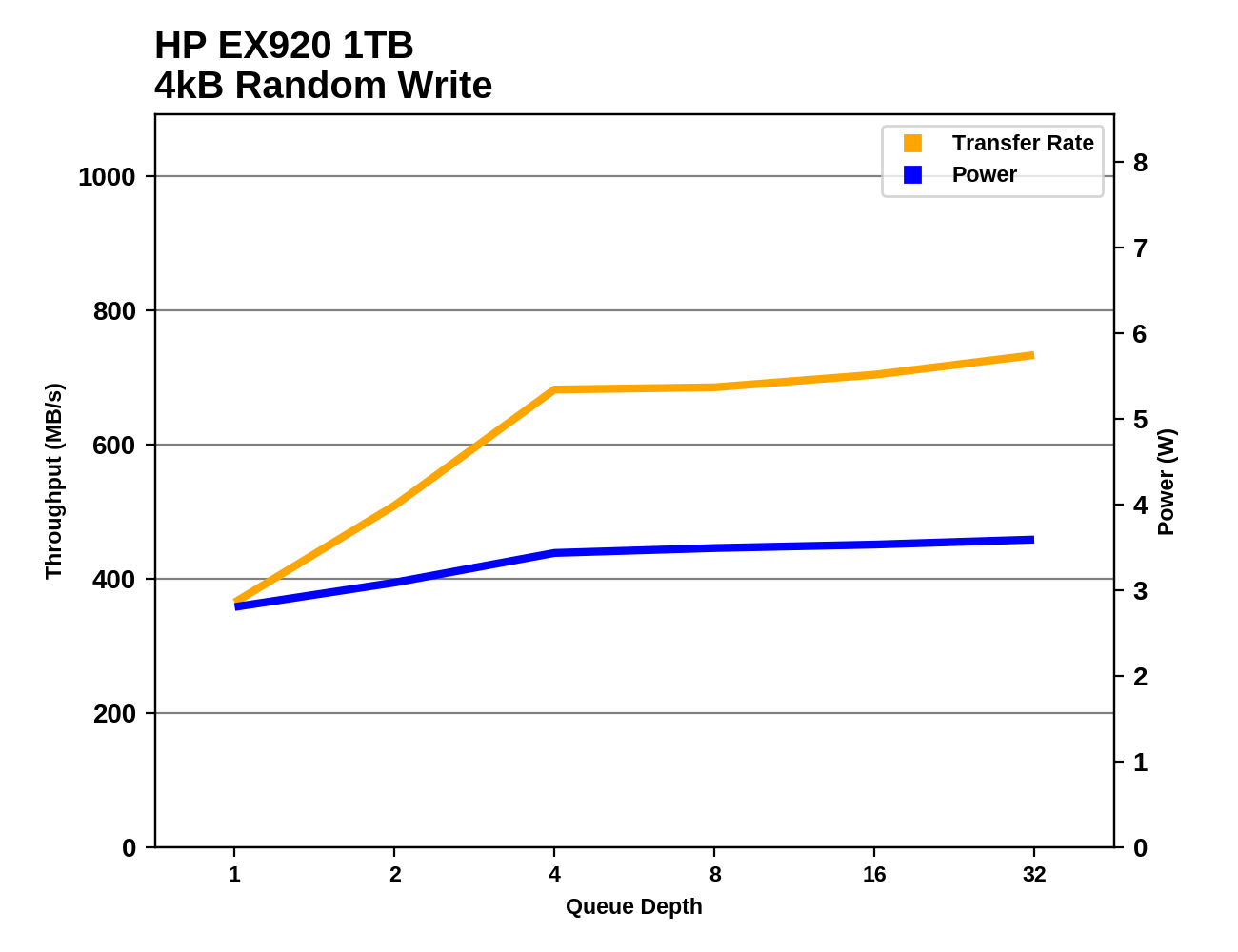The HP EX920 M.2 SSD Review: Finding the Mainstream Sweet Spot
by Billy Tallis on July 9, 2018 9:00 AM ESTRandom Read Performance
Our first test of random read performance uses very short bursts of operations issued one at a time with no queuing. The drives are given enough idle time between bursts to yield an overall duty cycle of 20%, so thermal throttling is impossible. Each burst consists of a total of 32MB of 4kB random reads, from a 16GB span of the disk. The total data read is 1GB.

The HP EX920 surprises with a new record high burst random read performance from a flash-based SSD. It's still nothing compared Intel's Optane SSDs, but it's a substantial improvement over the competition. Even the MLC-based drives can't beat the EX920 on this test.
Our sustained random read performance is similar to the random read test from our 2015 test suite: queue depths from 1 to 32 are tested, and the average performance and power efficiency across QD1, QD2 and QD4 are reported as the primary scores. Each queue depth is tested for one minute or 32GB of data transferred, whichever is shorter. After each queue depth is tested, the drive is given up to one minute to cool off so that the higher queue depths are unlikely to be affected by accumulated heat build-up. The individual read operations are again 4kB, and cover a 64GB span of the drive.

On the longer random read test, the HP EX920 no longer stands out, but it's securely within the high-end performance bracket and isn't too far behind the fastest TLC SSD.
 |
|||||||||
| Power Efficiency in MB/s/W | Average Power in W | ||||||||
The power efficiency of the EX920 during the sustained random read test is poor, but the Samsung 970 EVO's score is almost as bad. Both drives need to improve a lot to match the WD Black or even the Toshiba XG5, which are a bit slower but draw a full 1W less power during the test.
 |
|||||||||
The random read performance of the HP EX920 is very competitive at QD1 and QD2, but by QD4 the top drives are starting to pull away. At the highest queue depths, the EX920 is performing far below most other 1TB NVMe SSDs, but fortunately this poor scalability has little relevance to real-world client/consumer workloads.
Random Write Performance
Our test of random write burst performance is structured similarly to the random read burst test, but each burst is only 4MB and the total test length is 128MB. The 4kB random write operations are distributed over a 16GB span of the drive, and the operations are issued one at a time with no queuing.

The burst random write performance of the HP EX920 isn't quite the fastest we've measured, but it's still excellent. The Intel 760p managed a few percent faster with the same controller, but it's the WD Black that currently seems to have the fastest SLC write cache.
As with the sustained random read test, our sustained 4kB random write test runs for up to one minute or 32GB per queue depth, covering a 64GB span of the drive and giving the drive up to 1 minute of idle time between queue depths to allow for write caches to be flushed and for the drive to cool down.

On the longer random write test, the HP EX920 isn't quite in the top tier of drives, but it still performs better than most of the older high-end NVMe SSDs like the RD400 and XG5.
 |
|||||||||
| Power Efficiency in MB/s/W | Average Power in W | ||||||||
The power efficiency of the HP EX920 during the sustained random write test is good, but can't compete with the WD Black and Toshiba XG5. It's still a huge improvement over Silicon Motion's previous generation as represented here by the Intel 600p.
 |
|||||||||
Like most other high-end NVMe SSD, the EX920 has mostly saturated its random write potential by QD4, with only a little more performance available by going all the way to QD32. The problem for the EX920 is that its limit is quite a bit lower than most of its competition, so it quickly falls behind as queue depths increase.










32 Comments
View All Comments
Hectandan - Friday, July 13, 2018 - link
So? Even if your figure is correct, iPhone should have been selling for maybe $200 or $300.Companies have ZERO duty to ignore their R&D, facilities, and market demand and price at production cost.
5080 - Sunday, November 25, 2018 - link
Amazing how the prices have tumbled. I just bought a 512GB one for $80 on Black Friday from Neweggs Ebay store. https://www.ebay.com/itm/382428249840